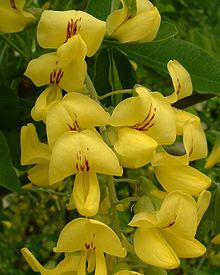Laburnum
| Laburnum | |
|---|---|
 |
|
| Common laburnum – flowers | |
| Scientific classification | |
| Kingdom: | Plantae |
| (unranked): | Angiosperms |
| (unranked): | Eudicots |
| (unranked): | Rosids |
| Order: | Fabales |
| Family: | Fabaceae |
| Subfamily: | Faboideae |
| Tribe: | Genisteae |
| Genus: |
Laburnum Fabr. |
| Species | |
|
See text. |
|
See text.
Laburnum, sometimes called golden chain, is a genus of two species of small trees in the subfamily Faboideae of the pea family Fabaceae. The species are Laburnum anagyroides—common laburnum and Laburnum alpinum—alpine laburnum. They are native to the mountains of southern Europe from France to the Balkans.
Some botanists include a third species, Laburnum caramanicum, but this native of southeast Europe and Anatolia is usually treated in a distinct genus Podocytisus, more closely allied to the Genisteae ("brooms").
The Laburnum trees are deciduous. The leaves are trifoliate, somewhat like a clover; the leaflets are typically 2–3 cm (1–1 in) long in L. anagyroides and 4–5 cm (1.5–2 in) long in L. alpinum.
They have yellow pea-flowers in pendulous leafless racemes 10–40 cm (4–15.5 in) long in spring, which makes them very popular garden trees. In L. anagyroides, the racemes are 10–20 cm (4–8 in) long, with densely packed flowers; in L. alpinum the racemes are 20–30 cm (8–12 in) long, but with the flowers sparsely along the raceme. The fruit develops as a pod and is extremely poisonous, it can be used medicinally.
The yellow flowers are responsible for the old poetic name 'golden chain tree' (also spelled golden chaintree or goldenchain tree).
All parts of the plant are poisonous, although mortality is very rare. Symptoms of laburnum poisoning may include intense sleepiness, vomiting, convulsive movements, coma, slight frothing at the mouth and unequally dilated pupils. In some cases, diarrhea is very severe, and at times the convulsions are markedly tetanic. The main toxin in the plant is cytisine, a nicotinic receptor agonist.
...
Wikipedia
